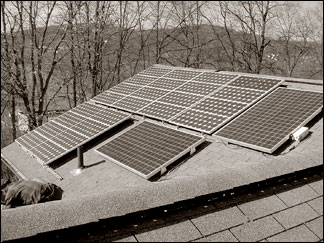Solar power for South Asian villages
Is it a solution the looming energy crisis?:
by Indeewara Thilakarathne
[email protected]
One of the positive outcomes of the looming energy crisis is the
renewed interest generated in alternative sources of energy. Wind, solar
and bio-fuel are some of the potential alternative energy sources that
can be harnessed in sun-lit villages in South Asian.
 Given the sustainability and low cost of maintaining unites, solar
power is considered ideal source of energy for far-flung villages which
are off the national grid. As the sun-light is in abundance throughout
the year, small solar-panels can provide sufficiently electricity for a
household for its cooking and lighting requirements. Given the sustainability and low cost of maintaining unites, solar
power is considered ideal source of energy for far-flung villages which
are off the national grid. As the sun-light is in abundance throughout
the year, small solar-panels can provide sufficiently electricity for a
household for its cooking and lighting requirements.
Although solar energy has been used for centuries by Greeks, Native
Americans and Chinese for warming houses, the modern use of solar energy
ranges from providing heating, lighting, electricity and even flight.
However, most popular form of solar energy in modern-day context is
the converting solar energy into electricity. This is mainly done either
through the photovoltaic effect or transferring heating to power a
generator. Currently solar photovoltaics provide 0.04% of the world's
energy requirement.
The technologies harnessing solar energy varies as their applications
such as for producing food, head, light and electricity and also use for
commercial and industrial transportation sectors.
Although taken for granted, entire agriculture and food production
and even the sustenance of live on earth is dependent on solar energy as
plants produces food through the Photosynthesis.
PV power plants
The genera perception of solar power is more or less focused on
small-scale use of solar cells which are capable of producing
electricity for a household. However, for large scale electricity
generation, solar thermal powers, has been harnessed in many parts of
the world.
A solar cell or photovoltaic cell is a transparent cell which
converts sunlight into electricity. By the end of 2006, it has been
calculated that total power generated by PV is 6,000 MW and it has been
projected that generation ability will pass the 9,000 MW by 2008.
Mass production of solar panels or PV
In order to popularise the solar technology among the village folks
in the South Asian region, it is inevitable that PV cells have be
locally manufactured enmass. Government can encourage private sector and
especially SME sector to invest in Solar technology so that the PV be
available in villages at a reasonable price.
It is also important to impart necessary technical know how to the
end-user of the PV in order that they may be in a position to maintain
them.
So far India has successfully introduced PV in far flung hamlets that
have not seen the electricity, thus lighting up the lives of the folks.
Less independence on national grid and small and medium-scale PV would
be a solution to the looming energy crisis precipitated by the
increasing prices of oil. |
